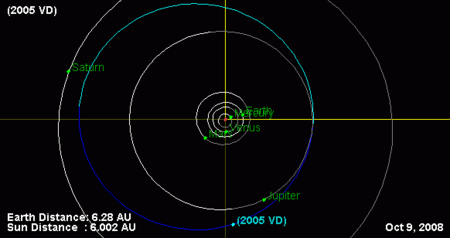(434620) 2005 VD
| Discovery | |
|---|---|
| Discovery date | 1 November 2005 |
| Designations | |
| MPC designation | 2005 VD |
| damocloid[3] | |
| Orbital characteristics[1] | |
| Epoch 13 January 2016 (JD 2457400.5) | |
| Uncertainty parameter 2 | |
| Observation arc | 4163 days (11.40 yr) |
| Aphelion | 8.34161 AU (1.247887 Tm) (Q) |
| Perihelion | 4.989394 AU (746.4027 Gm) (q) |
| 6.66550 AU (997.145 Gm) (a) | |
| Eccentricity | 0.251460 (e) |
| 17.21 yr (6285.61 d) | |
| 205.5636° (M) | |
| 0° 3m 26.185s / day (n) | |
| Inclination | 172.8679° (i) |
| 173.2668° (Ω) | |
| 178.4741° (ω) | |
| Earth MOID | 3.98292 AU (595.836 Gm) |
| Jupiter MOID | 0.0186987 AU (2.79729 Gm) |
| Jupiter Tisserand parameter | -1.393 |
| Physical characteristics | |
| Dimensions | ~9.6 km |
| 0.04 (assumed dark) | |
| 14.3[1] | |
|
| |
(434620) 2005 VD is a centaur and damocloid. It has the second most highly inclined orbit of any known object in the solar system, second to 2013 LA2. It was the most highly inclined known object between 2005 and 2013.
Classification
2005 VD has a semi-major axis greater than Jupiter and almost crosses the orbit of Jupiter when near perihelion. JPL lists it as a current centaur.[1] Both the Deep Ecliptic Survey (DES),[2] and the Minor Planet Center (MPC)[4] have listed it as a centaur (qmin=~5AU) at different epochs. The DES and MPC will list as a centaur again in 2032.
Lowell Observatory also has it listed as a damocloid object.[3]

2005 VD makes occasional close approaches to Jupiter, coming only 0.0817 AU from Jupiter in 1903, 0.0444 AU in 2057, and 0.077 AU in 2093. However the closest approach it will make in the next decade will only be 0.3089 AU on December 17, 2022.[1]
References
- 1 2 3 4 5 "JPL Small-Body Database Browser: (2005 VD)" (last observation: 2013-05-14). Retrieved 8 April 2016.
- 1 2 Marc W. Buie (2006-08-28). "Orbit Fit and Astrometric record for 05VD". SwRI (Space Science Department). Archived from the original on 2009-09-02. Retrieved 2008-10-10.
- 1 2 Akimasa Nakamura (2009-05-02). "Table of Damocloid objects, or Oort cloud asteroids". Lowell Observatory. Retrieved 2014-11-14.
- ↑ "List Of Centaurs and Scattered-Disk Objects". Minor Planet Center. Archived from the original on 2013-04-12. Retrieved 2010-07-16.
External links
- Orbital simulation from JPL (Java) / Ephemeris
- (434620) 2005 VD at the JPL Small-Body Database